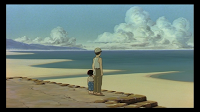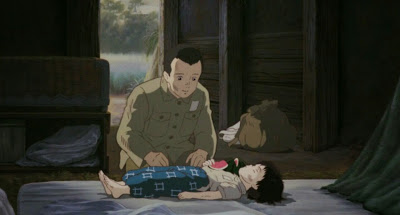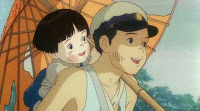A TRIBUTE TO A MASTERPIECE
In a world poisoned with sensationalism and hype, this little masterpiece entered my life quietly and without fanfare. I did not know of it, so I did not seek it. But it found me – and at a dark time when I needed solace. It renewed my wounded belief in the transformative power of art. It reminded me that a thinker/writer can touch people deeply and awaken and comfort them.
It is called THE GRAVE OF THE FIREFLIES and it is a Japanese animated film. The title alone is steeped in the mysterious inscrutability of the Orient. One immediately realizes that fireflies don’t get buried, so what could this mean? But to the sensitive, caring four year old girl, who found their dead bodies in the morning, it made complete sense to give them a respectful funeral.
Most viewers consider this “an anti-war movie,” but the director feels otherwise, and I agree. Yes, the wrenching tragedy that befalls the two young characters is a direct result of the horror, senselessness and evil of industrial warfare. But the story tunnels much deeper into the human psyche, and indicts us for a more profound crime – our sad capacity for being callous when the situation is crying out for compassion. For the two little orphans had survived the grotesque firebombing of Kobe, Japan but they were doomed by the adults around them, who should have been sensitive – but instead were selfish.
All of the various elements of the film are woven together masterfully. The music, the story told in seamless, non-jarring flashbacks, the frequent use of lush backgrounds for the animated characters, the subtle inclusion of playful and peaceful moments despite their difficult situation, and the minimal but highly charged dialogue – all combine in such a poignant and powerful manner that it becomes celluloid poetry.
*******
It is the story of a 15 year old boy named Seika and his 4 year old sister, Setsuko. Their mother is killed in the bombing attack and their father is away serving as a naval officer. The two orphans initially stay with an aunt, but her indifference towards them swiftly turns into outright hostility. Her uncaring attitude is so severe that she even withholds food from them.
Feeling trapped by their miserable conditions, they decide to forge out on their own and go live in a nearby cave where they strive to reclaim some simple but austere happiness. The scenes of their innocent efforts to pry some joy out of a bleak daily existence are sublimely life-affirming.
 Their day at the beach and the first night in the cave with the twinkling magic of the fireflies, pull at one’s heartstrings and at one’s conscience. The use of the inexpensive fruit drops candy as a tiny treat in their grim world of near starvation is exquisite. And then the use of the battered tin container from that candy as an urn for Setsuko’s ashes is almost overwhelmingly delicate and wistful.
Their day at the beach and the first night in the cave with the twinkling magic of the fireflies, pull at one’s heartstrings and at one’s conscience. The use of the inexpensive fruit drops candy as a tiny treat in their grim world of near starvation is exquisite. And then the use of the battered tin container from that candy as an urn for Setsuko’s ashes is almost overwhelmingly delicate and wistful.
*******
What astonishes me most about this modest, simple little film is that it probes so deeply – it questions so profoundly the direction of the human project. Certainly, we are flawed as a species, but can we be so blind to the struggle of these two innocents, that we do not lift a hand to even help them stay alive?
Their desperate battle against the uncaring forces that surround them is symbolic of the larger war that we seem to be waging against basic human decency. How can we continue to permit behavior that is so damaging to our human brothers and sisters, our fellow animal travelers and the rest of the Earth Community? Look around the world carefully with truly open eyes and what do you see?
The massive political structures – the democracies and the republics – that are supposed to manage and stabilize our societies have become servants of the rich instead of protectors of the vulnerable.
The dominant economic system, Capitalism, is not “lifting all boats” it is floating the megayachts of the rulers – while everyone else fights for survival on the shoreline.
The mammoth religions do not unite and assist the people of the planet. Instead, they inflame animosities. They have become the headwaters for rivers of blood.
Technology does not enrich us. It distracts us with false “connectivity.” And it worships the forces of Mordor. So many of our best human minds are devoted to the creation of vicious and obscene weapons of war. And civilian technology shames itself by designing self-driving cars instead of trying to defeat disease and starvation.
For me the overarching message of THE GRAVE OF THE FIREFLIES is that the human project has become pathologically misguided. How do we fail to see that our great institutions and value systems are not increasing happiness, instead they are spreading misery. How can we not appreciate the immense blessing of gliding through space on the one inhabitable planet amidst billions of lifeless stars? How do we not marvel at the variety of species and the majesty of their habitats?
Gifted with the treasure of consciousness and self-awareness, we humans are squandering our amazing good fortune. The foolish and violent way that we are progressing and evolving is nothing short of shameful. We are degrading and humiliating ourselves. The sad story of Seika and little Setsuko reminds us of this insane tragedy – and it does this powerfully and poignantly and poetically.
*******
From the very outset of the film, the viewer knows that there will not be a happy ending, and that it will be almost unbearable. For me, it was such agony, that it felt like my very soul had been firebombed. But Setsuko’s death scene is heroically exquisite in all that it communicates with the simplest actions and words. It reaffirms, with understated power, the fact that there are still traces of nobility in the human spirit.
Her brother has had to leave her in their little cave as he desperately seeks more help. Finally he is able to get some real food and even some luxurious treats. But when he returns, her starvation and dehydration has worsened and she is barely clinging to life. He kneels beside her stretched out, emaciated little body and describes the wonderful food he has returned with, that will allow her to regain her strength.
He cuts a slice of watermelon, which harkens up the memory of her beloved fruit drops, which were eaten so long ago. Then he tilts up her head and places the fruit in her mouth. It is wet and sweet and delicious. It will be her last sensual experience in her so short and so tragic life. Then she looks up at her brother – and even though she is only four years old – she knows this is farewell. And she says to him,
“Seika, thank you.”
But she is only partially thanking him for the watermelon.
Mostly, she is thanking him for his care
and for his kindness
and for his love.
Here is a link to this beautiful work of art. I prefer the Japanese language with English subtitles version, but was not able to upload one for you.
https://www.youtube.com/watch?v=u_7BE0LxIYk&feature=em-share_video_user&noredirect=1
For my many Japanese readers, I hope you will circulate this widely and perhaps recommend the essay to the English language newspapers scattered about Japan. I also hope that my little tribute finds its way to the producer, director and artists of this extraordinary film.




